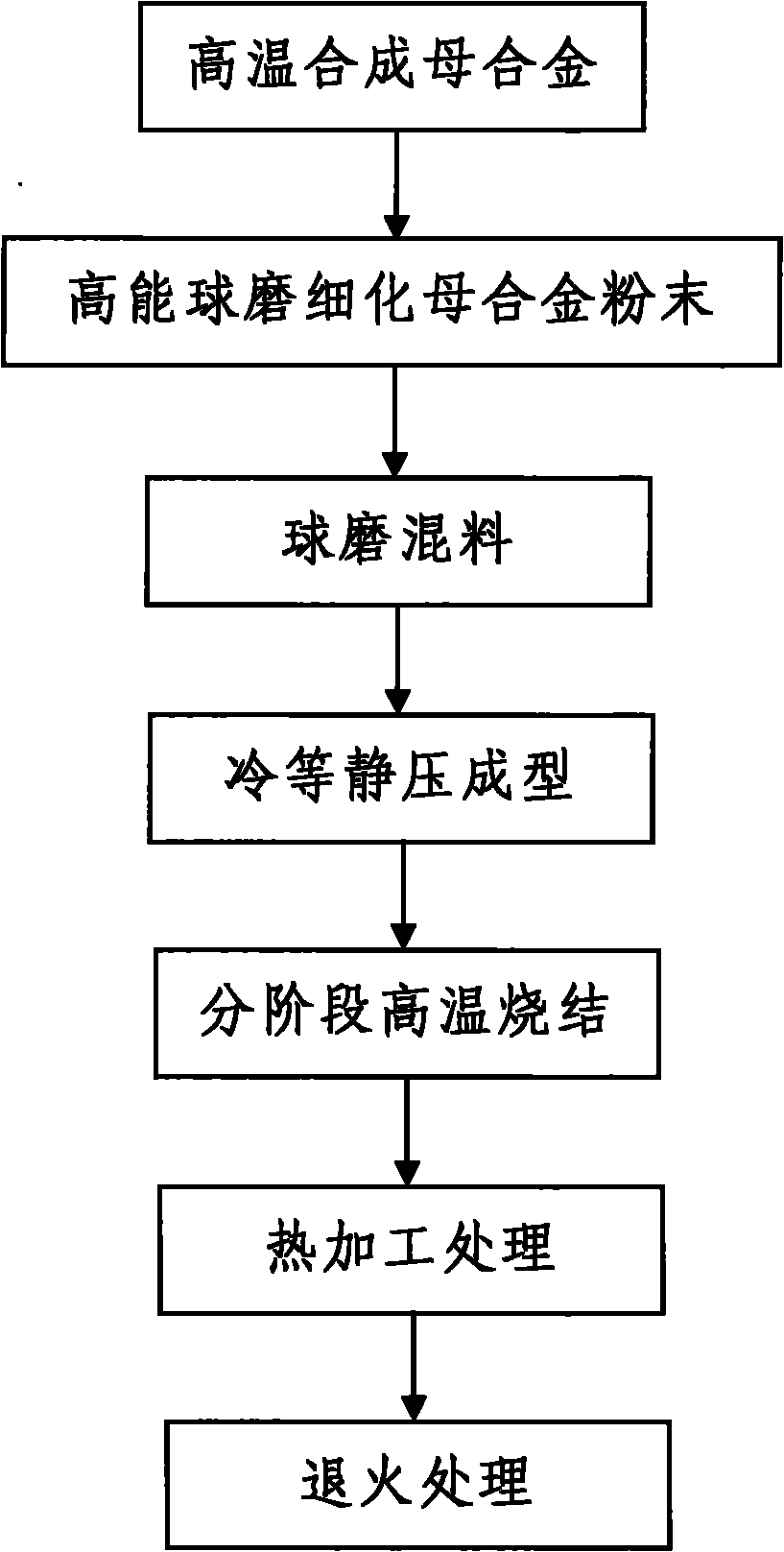Method for preparing superhigh temperature resistant iridium alloy by using powder metallurgy method
A powder metallurgy and ultra-high temperature technology is applied in the field of preparation of ultra-high temperature resistant iridium alloys, which can solve the problems of large loss of raw materials, high process difficulty and high manufacturing cost, and achieve the effects of small loss of precious metals, simple process and convenient operation.
- Summary
- Abstract
- Description
- Claims
- Application Information
AI Technical Summary
Problems solved by technology
Method used
Image
Examples
Embodiment 1
[0046] In the present embodiment, when powder metallurgy prepares iridium alloy Ir-4Zr-0.3W (wt%), its preparation process is as follows:
[0047] Step 1. Synthesis of master alloy at high temperature: determine the ratio of each component of the master alloy to be synthesized into the final iridium alloy and the synthesis temperature according to the alloy phase diagram, and then uniformly mix the powders of each component according to the determined ratio, Perform cold isostatic pressing to form a billet, and then put the pressed billet into a vacuum furnace for high-temperature synthesis until the full reaction between the components is completed, and then the master alloy is obtained.
[0048] Specifically: select iridium powder (average particle size is 37μm, purity 99.99%), ZrH 2 powder (average particle size is 1.04 μm, purity 99%) and W powder (average particle size is 3 μm, purity 99.9%) to prepare master alloy powder, 20g iridium powder, 4g ZrH 2 The powder is mixed...
Embodiment 2
[0058] In this example, the difference from Example 1 is: in step 2, after performing high-energy ball milling to refine the master alloy powder, an ultrafine master alloy powder with an average particle size of 50 μm is obtained; in step 3, when using a planetary ball mill for ball milling, The ball milling time is 1h; when performing high-temperature sintering treatment in step 5, the powder compact is sintered at high temperature in stages using a high-temperature sintering furnace, first at 1800°C for 2 hours, and then at a temperature lower than the final iridium alloy Sintering at the temperature of the lowest phase melting point of 120°C for 8 hours, and then cooling to room temperature with the furnace; when performing thermal processing in step 6, use forging and / or rolling equipment to forge the powder compacts that have been sintered at high temperature And / or rolling processing, and when forging or rolling processing is carried out, the processing temperature is 150...
Embodiment 3
[0060] In this example, the difference from Example 1 is: in step 2, the master alloy powder is refined by high-energy ball milling, and the master alloy ultrafine powder with an average particle size of 60 μm is obtained; in step 3, when the planetary ball mill is used for ball milling , the ball milling time is 5h; when high-temperature sintering treatment is carried out in step 5, the high-temperature sintering furnace is used to carry out high-temperature sintering of the powder compact in stages, first sintering at 1750 ° C for 2.5 hours, and then at a temperature lower than the final iridium The lowest phase melting point of the alloy is sintered at a temperature of 110°C for 5 hours, and then cooled to room temperature with the furnace; when thermal processing is performed in step 6, the processing temperature is 1300°C and the processing time is 30 minutes; when annealing is performed in step 7 , the annealing temperature is 1300°C, and the annealing time is 2.5 hours. ...
PUM
 Login to View More
Login to View More Abstract
Description
Claims
Application Information
 Login to View More
Login to View More - R&D
- Intellectual Property
- Life Sciences
- Materials
- Tech Scout
- Unparalleled Data Quality
- Higher Quality Content
- 60% Fewer Hallucinations
Browse by: Latest US Patents, China's latest patents, Technical Efficacy Thesaurus, Application Domain, Technology Topic, Popular Technical Reports.
© 2025 PatSnap. All rights reserved.Legal|Privacy policy|Modern Slavery Act Transparency Statement|Sitemap|About US| Contact US: help@patsnap.com


